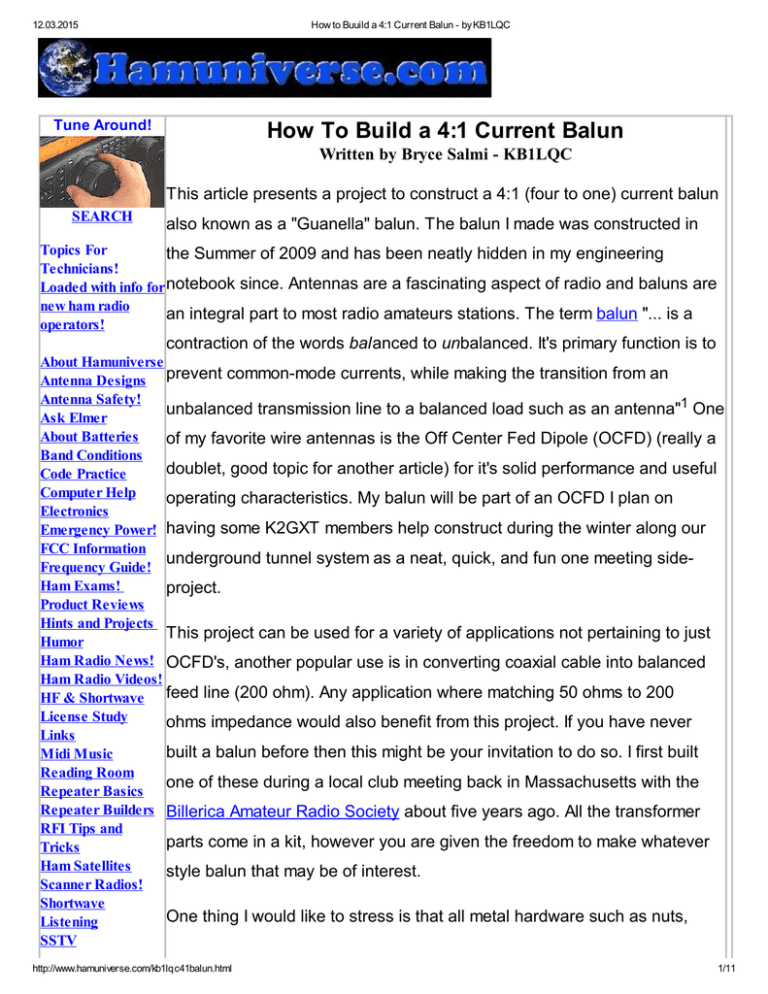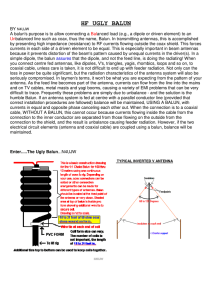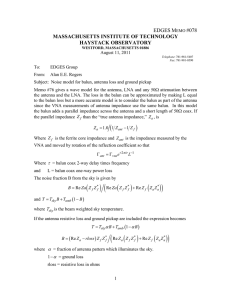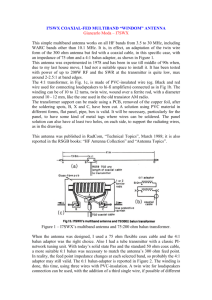
12.03.2015
How to Buuild a 4:1 Current Balun - by KB1LQC
Tune Around!
How To Build a 4:1 Current Balun
Written by Bryce Salmi - KB1LQC
This article presents a project to construct a 4:1 (four to one) current balun
SEARCH
also known as a "Guanella" balun. The balun I made was constructed in
Topics For
the Summer of 2009 and has been neatly hidden in my engineering
Technicians!
Loaded with info for notebook since. Antennas are a fascinating aspect of radio and baluns are
new ham radio
an integral part to most radio amateurs stations. The term balun "... is a
operators!
contraction of the words balanced to unbalanced. It's primary function is to
About Hamuniverse
Antenna Designs prevent common-mode currents, while making the transition from an
Antenna Safety!
unbalanced transmission line to a balanced load such as an antenna"1 One
Ask Elmer
About Batteries
of my favorite wire antennas is the Off Center Fed Dipole (OCFD) (really a
Band Conditions
doublet, good topic for another article) for it's solid performance and useful
Code Practice
Computer Help
operating characteristics. My balun will be part of an OCFD I plan on
Electronics
Emergency Power! having some K2GXT members help construct during the winter along our
FCC Information
underground tunnel system as a neat, quick, and fun one meeting sideFrequency Guide!
Ham Exams!
project.
Product Reviews
Hints and Projects
This project can be used for a variety of applications not pertaining to just
Humor
Ham Radio News! OCFD's, another popular use is in converting coaxial cable into balanced
Ham Radio Videos!
HF & Shortwave feed line (200 ohm). Any application where matching 50 ohms to 200
License Study
ohms impedance would also benefit from this project. If you have never
Links
built a balun before then this might be your invitation to do so. I first built
Midi Music
Reading Room
one of these during a local club meeting back in Massachusetts with the
Repeater Basics
Repeater Builders Billerica Amateur Radio Society about five years ago. All the transformer
RFI Tips and
parts come in a kit, however you are given the freedom to make whatever
Tricks
Ham Satellites
style balun that may be of interest.
Scanner Radios!
Shortwave
One thing I would like to stress is that all metal hardware such as nuts,
Listening
SSTV
http://www.hamuniverse.com/kb1lqc41balun.html
1/11
12.03.2015
How to Buuild a 4:1 Current Balun - by KB1LQC
Support The Site
STORE
Vhf and Up
Contact
Site Map
Privacy Policy
Legal Stuff
washers, and bolts are stainless
Submit a
Project/Article!
helps keep a good electrical and
ADVERTISING
INFO
However, you cannot solder to
steel in this project. Any metal
hardware used on antennas should
be stainless steel when possible
because it will not corrode which
mechanical connection for years.
stainless steel which demands other
methods of joining the metal such
as nuts and bolts.
Designing and Building the
Balun
The easiest way to start building a 4:1 current balun is to order the AB240250 K Mix Balun Kit from
Amidon Associates. This kit
includes the proper toroidal
core, 12.5 feet of #14 magnet
wire, 12.5 feet of Teflon tubing,
and the Transmission Line Transformer Handbook2 by Jerry Sevick,
W2FMI. Everything you need to build the balun is included including
instructions on winding the wire. The current balun I chose to build for my
off center fed dipole is the HBM200 on pg. 31 of the Transmission Line
Transformer Handbook. With this kit not only do you get to learn more
about transmission line transformers but it's hard to beat the price ($25
when I bought mine) when most commercial current baluns can cost
several times as much.
The HBM200 can handle 2KW (2000 Watts) of continuous power
indefinitely and support peak power levels of 4KW when matched correctly.
http://www.hamuniverse.com/kb1lqc41balun.html
2/11
12.03.2015
How to Buuild a 4:1 Current Balun - by KB1LQC
The largest enemy to toroids comes in the form of overheating which can
crack them, rendering the balun useless. This design is engineered by
W2FMI to be 98% efficient which means little heat will be created inside the
balun during operation. To properly match the 50 ohm coaxial cable to the
feed-point impedance the balun performs the 4-to-1 transformation 50
ohms * 4 = 200 ohms and the opposite for receiving which converts the 200
ohms to 50 ohms.
Winding the Toroid
The most dreaded part about building a balun is winding the transformer.
To be honest I used to avoid building an electronic circuit if it had a toroidal
inductor in it that I had to wind, they scared me. It also wouldn't be
surprised if I wasn't the only one to
be intimidated, then again, I'm in for
a surprise every now and then!
There is a nifty trick to make
winding toroids much easier. To
count windings on the core you only
count the windings that go through
the center, it looks like a donut so in all reality it's not hard at all. It is also a
good idea to label the end of each wire with a small piece of tape or color
marking for future reference. I attached small bits of masking tape with
appropriate numbers (shown in schematic) on each wire-end once
seperated into two wire-pairs with eight ends total. The reader will see how
this approach comes in handy further ahead in the article.
http://www.hamuniverse.com/kb1lqc41balun.html
3/11
12.03.2015
How to Buuild a 4:1 Current Balun - by KB1LQC
The first step to constructing the transmission line transformer is to prepare
the wire for winding. Take the magnet wire and slip the Teflon tubing over
the entire length, both wire and tubing should be close in length, but may
not be exact. Once this is done fold the wire end-to-end and cut at the
crease which is obviously the center of the wire. Pair both wires together
evenly and secure with electrical or medical tape which also works good,
the Teflon tubing is the dielectric, not the tape which is just securing the
wires together. Space the tape several inches down the entire length of
wire. There should now be roughly six feet of paired Teflon covered wirepair ready for winding on the toroidal core. The 4:1 current balun uses two
bifilar windings each containing eight turns. A bifilar winding simply means
that are two wires following each other. Similarly we would use three wires
in a trifilar winding, simple eh? Start by leaving about one inch of wire
hanging off the end to connect to later. Make one turn through the toroid as
tightly as possible, it doesn't matter what direction you wind in whether it be
clockwise or counter-clockwise. After making the winding secure with a
wire tie to hold the wire in place. For my current balun design I continued to
wind a total of eight turns through the center of the toroid. Try to wind them
tightly but not overlapping. Fitting all the wire on the toroid is a tight
squeeze at best. Leave a few inches off the end to connect at another time
and cut the several feet of wire-pair off to use on the other side of the
toroid. Half of the toriod should now have wire on it, the other half should
still be bare.
With the first winding done, the
hardest part is almost over. Take
the remaining paired wire and do
the same method on the other half
of the toroid except this time wind in
the opposite direction. For example,
http://www.hamuniverse.com/kb1lqc41balun.html
4/11
12.03.2015
How to Buuild a 4:1 Current Balun - by KB1LQC
if you wound clockwise first now wind counter-clockwise starting from the
same end. There should be enough wire to make both windings tightly with
a little left over to make connections with. Don't worry about a little overlap
near the end of the windings, refer to the pictures for examples of a
correctly wound balun. When it's clear that all your handiwork is correct,
secure the end of the second winding with a wire tie.
Now we get to solder the wires together to get a functioning transmission
line transformer. Following the schematics shown above, which should
make sense since we already labeled the wires before winding (I hope you
did!), take wire-end number one and connect it to wire-end number five
which should be right next to it. Also connect ends four and six together
with short wire leads. Ends three and seven are connected together to
make the center conductor wire pair for the 50 ohm side. Ends two and
eight should be free and are used to connect to the antenna, they should
be left long for now. Be careful not to short the wires out on the toroid
which will not end well if power is applied, just keep some of the Teflon
tubing long enough to protect the end of each wire. I heat-shrinked the
exposed solder connections as can be seen and used appropriately sized
eye-hole mounting hardware to attached to the stainless-steel screws.
Connecting it all Together
It's time to put the balun down and focus on where to install it. Since my
design was going to be outside I needed to consider weatherproofing the
balun. I decided that I was going to use an antenna insulator to hang the
balun below rather than use the balun enclosure as structural support. This
is convenient because I don't have to worry about the tension the antenna
http://www.hamuniverse.com/kb1lqc41balun.html
5/11
12.03.2015
How to Buuild a 4:1 Current Balun - by KB1LQC
wires will apply when installed while
finding an enclosure. I chose to use
a Philmore brand plastic enclosure
bought at a local electronics shop
called "Electronics Plus" in Littleton,
Massachusetts (they still exist!).
Alternatively, PVC piping can be used just like some baluns on the market
that you can buy. However, I have found by experience that PVC tends to
be heavy and causes a lot of sagging on the antenna, very undesirable.
The pictures below show how I decided to mount the balun inside the case.
It is really important to keep wires on the coaxial cable side of the balun as
short as possible. My connection to the N-type chassis mount connector
was about 2cm long. The ground connection was made to a screw holding
on the connector with a #8 solder lug (eye-hole) and 4-40 screws while I
soldered in a small piece of #14 wire to the center conductor since it was
accidentally too short, learn from my mistakes and try to avoid that if
possible. I use N-type connectors since they are actually 50 ohms and
rather weather resistant unlike SO-239 UHF connectors which are well
known to not be 50 ohms due to the soldered center conductor and need
considerable help weatherproofing. however, this is personal preference in
the end.
Attaching the 200 ohm end of the balun to the antenna isn't as critical with
length; the wire are now part of the antenna. I had about 6 cm of the wires
left so I went up three centimeters and out three centimeters to make the
connection with #8 solder lugs attached to the external bolts. This kind-of
mimicked where the wire in the antenna should be, though I am confident
http://www.hamuniverse.com/kb1lqc41balun.html
6/11
12.03.2015
How to Buuild a 4:1 Current Balun - by KB1LQC
that this more aesthetic than
practical at HF wavelengths. The 832 screws used for the antenna
connections were installed from the
inside out so they could be locked in
place with nuts and worked with
easier. Three nuts were used per bolt per side.
The balun is mounted securely by being squeezed between two pieces of
Plexiglas and a two inch #10 bolt used to position the balun so that the
connectors don't have much tension on them. Squeezing the balun in place
protects against mechanical vibrations that could crack the soldered
connections over time. I like making projects as failsafe as possible; good
electrical and mechanical connections must be accounted for. Additionally,
the metal bolt does not affect the baluns performance because an ideal
balun contains the magnetic field within the toroidal core.
Testing the Balun
The best way to test the current balun is with an antenna analyzer like the
MFJ-269 antenna analyzer. While one could hope for the best and just
throw the balun on the air, I enjoy testing prior to installation. Testing the
4:1 Guanella current balun is easy to do. Since we are matching 50
ohms to 200 ohms all that really needs to be done is attach 200
ohms across the antenna terminals. The MFJ antenna analyzer doesn't put
out much power so two 1/4 watt 100 ohm resistors in series worked fine.
For best results keep the connections as short as possible, refer to the
pictures for a better idea of my setup.
http://www.hamuniverse.com/kb1lqc41balun.html
7/11
12.03.2015
How to Buuild a 4:1 Current Balun - by KB1LQC
The baluns' test
resistive load
measured 196.8
ohms with a multimeter,
close enough for me.
The total length of the
load was about seven
inches between the
terminals. With RF one
must keep connection
lengths as short as
possible. The table and
graph show the
resulting VSWR values
measured with the MFJ
antenna analyzer attached to the 50 ohm connector as shown in many of
the photographs. The broadband performance of the balun shows that it's
doing its job very well and I was satisfied with its performance of 1.3:1
across the HF spectrum. A VSWR performance of better than 1.5:1 is likely
better than other portions of the antenna system such as SO-239 and PL259 connectors, so I'm not worried about the 1.3:1 SWR at the balun. To
further test the balun, connect the ground lead on the coaxial cable side to
both sides of the antenna terminals and between the two 100 ohm resistors
independently measuring while at each location. If the balun stays relatively
stable your in good shape, mine jumped to a 2:1 SWR when doing this
which is fine; jumps of SWR greater than 10:1 should cause concern. This
is however a rough test so take it in stride.
http://www.hamuniverse.com/kb1lqc41balun.html
8/11
12.03.2015
How to Buuild a 4:1 Current Balun - by KB1LQC
Final Assembly
This baluns' mechanical design cannot support a large amount of weight or tension
alone. I plan on mounting the enclosure by attaching it to PVC, Plexiglas, or
fiberglass which in turn takes the tension and of the antenna. Some careful thought
should also be taken on supporting
the weight of the coaxial cable
hanging below the balun.
Supporting the coaxial cable to take
the load off of the Philmore case
might end up being crucial.
Another consideration would be
with the final weight of the balun
itself. A heavier balun will cause
more antenna sag.
The last step in construction of the balun is sealing it. RV sealant works really well
if applied generously. Apply the sealant to the antenna screws by backing them out
http://www.hamuniverse.com/kb1lqc41balun.html
9/11
12.03.2015
How to Buuild a 4:1 Current Balun - by KB1LQC
slightly and working some into the threads, tighten them back afterwards. Seal the
eye hook and balun Plexiglass bolt the same way. The best way to weatherproof
the N-type connector that I have found is to apply sealant around the edge and
over the nuts and bolts generously wherever water can get in. It might be best to
let the inside dry before sealing the lid down. The lid on my project box is sealed
last with a bead of sealant around the edge of the entire box cover followed by the
cover itself and screws to tightly hold the lid down. Some people may prefer to
drill a small hole at this time which always faces down allowing condensation inside
to drain out but rain to not get in.
Conclusion
This Guanella current balun is practical, relatively easy to construct, and
incredibly useful to all radio amateurs wishing to construct a worthy HF
antenna such as the off center fed dipole. Antenna performance is
considered by many, myself included, to be more important at times than
the performance of the radio. A bad antenna system will cause any radio to
under-perform. This balun will handle the full U.S. legal limit easily and
provides a bit of educational fun during construction. I encourage anyone
who finds this article helpful, inspiring, or that may have any questions or
corrections to let me know! Email...my call sign at arrl.net. KB1LQC
1: American Radio Relay League. "Coupling the Line to the Antenna." Antenna
Handbook . Ed. R. Dean Straw. 20th ed. 2005. 26.1-26.28. Print.
2: Transmission Line Transformer Handbook. Jerry Sevick. (You may be
able to find this book on the used market or do a search on Google for a
download...editor!)
Article and images by KB1LQC used with kind permission and taken from
http://www.collegearc.com
http://www.hamuniverse.com/kb1lqc41balun.html
10/11
12.03.2015
How to Buuild a 4:1 Current Balun - by KB1LQC
See lots more articles there!
© 2000 - 2015 N4UJW Hamuniverse.com and/or article author! - All Rights Reserved.
http://www.hamuniverse.com/kb1lqc41balun.html
11/11





